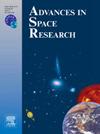Spatio-temporal characteristics of ionospheric irregularities in low latitude regions during the peak of solar cycle 25
IF 2.8
3区 地球科学
Q2 ASTRONOMY & ASTROPHYSICS
引用次数: 0
Abstract
Equatorial plasma bubbles (EPBs) are a primary source of ionospheric irregularities (IIR) in low-latitude regions. The severity of EPBs depends on the intensity, penetration, and disturbance of electric fields generated in the ionosphere. In this work, we analyze the IIR associated with geomagnetic activity in the low-latitude region (0°N–25°N, 90°E–110°E) from 2022 to 2024. The total electron content (TEC) and the rate of TEC index (ROTI) are used to investigate the spatiotemporal characteristics of these IIRs, influenced by both local EPBs and global geomagnetic storms. During low-to-moderate geomagnetic activity, electric field penetration and disturbances have a low impact on EPB development. The high solar activity intensifies the electric field, leading to intense EPB occurrences that can affect the entire region for several hours. From January 2022 to October 2024, these intense EPB events accounted for 35% of all EPB occurrences. During strong geomagnetic storms, the prompt penetration of electric fields (PPEF), and disturbance dynamo electric field (DDEF) caused the depression and fluctuations of TECs.
低纬度地区电离层不规则性在第25太阳活动周高峰期的时空特征
赤道等离子体气泡(EPBs)是低纬度地区电离层不规则性(IIR)的主要来源。epb的严重程度取决于电离层中产生的电场的强度、穿透性和扰动。在这项工作中,我们分析了2022年至2024年低纬度地区(0°N - 25°N, 90°E - 110°E)地磁活动相关的IIR。利用总电子含量(TEC)和总电子含量指数(ROTI)研究了局地强磁暴和全球强磁暴影响下总电子含量和总电子含量指数的时空特征。在中低地磁活动期间,电场穿透和扰动对EPB发育的影响较小。高太阳活动加剧了电场,导致强烈的EPB发生,可以影响整个地区几个小时。从2022年1月到2024年10月,这些强烈的EPB事件占所有EPB事件的35%。在强地磁风暴期间,电场的突防和扰动发电机电场导致tec的下降和波动。
本文章由计算机程序翻译,如有差异,请以英文原文为准。
求助全文
约1分钟内获得全文
求助全文
来源期刊

Advances in Space Research
地学天文-地球科学综合
CiteScore
5.20
自引率
11.50%
发文量
800
审稿时长
5.8 months
期刊介绍:
The COSPAR publication Advances in Space Research (ASR) is an open journal covering all areas of space research including: space studies of the Earth''s surface, meteorology, climate, the Earth-Moon system, planets and small bodies of the solar system, upper atmospheres, ionospheres and magnetospheres of the Earth and planets including reference atmospheres, space plasmas in the solar system, astrophysics from space, materials sciences in space, fundamental physics in space, space debris, space weather, Earth observations of space phenomena, etc.
NB: Please note that manuscripts related to life sciences as related to space are no more accepted for submission to Advances in Space Research. Such manuscripts should now be submitted to the new COSPAR Journal Life Sciences in Space Research (LSSR).
All submissions are reviewed by two scientists in the field. COSPAR is an interdisciplinary scientific organization concerned with the progress of space research on an international scale. Operating under the rules of ICSU, COSPAR ignores political considerations and considers all questions solely from the scientific viewpoint.
 求助内容:
求助内容: 应助结果提醒方式:
应助结果提醒方式:


